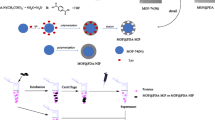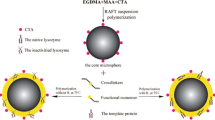Abstract
Protein-templated molecularly imprinted polymers have limitations such as poor mass transfer, slow recognition kinetics, and difficulties in isolation and purification due to their large molecular sizes, complex structures, and flexible conformations. To address these limitations and obtain lysozyme (Lyz)-imprinted polymers, a molecularly imprinted polymer (UiO66@DES-MIPs) was prepared for the first time by using Lyz as a template molecule, a metal–organic framework (UiO66-NH2) as a matrix, and a water-compatible deep eutectic solvent (DES) as a functional monomer. The introduction of UiO66-NH2 by the solvothermal method with a large specific surface area and favorable stability and resistance to environmental disturbances into the MIPs can reduce the “embedding” phenomenon and acquire a higher binding capacity and fast mass transfer. In addition, a water-soluble binary DES (1:2 molar ratio of choline chloride to 1,3 dimethylurea) prepared by a hydrothermal method as a functional monomer generates multiple forces with Lyz, increasing the hydrophilicity of UiO66@DES-MIPs and contributing to the formation and stabilization of the imprinted sites. Consequently, UiO66@DES-MIPs exhibited good selectivity, water compatibility, and fast adsorption equilibrium (the adsorption equilibrated at 243.87 ± 4.88 mg g−1 in 90 min). Besides, reusability experiments indicated that the UiO66@DES-MIPs could be recycled six times without obvious loss of adsorption capacity. The imprinting factor of UiO66@DES-MIPs is 3.67. The isolation and purification of Lyz from egg white confirmed the practicability of UiO66@DES-MIPs. The high adsorption capacity and specific recognition make this polymer a promising candidate for the isolation and purification of biological macromolecules.
Graphical Abstract





Similar content being viewed by others
Data availability
Data are available on request.
Abbreviations
- Lyz:
-
Lysozyme
- DES:
-
Deep eutectic solvent
- MIT:
-
Molecularly imprinted technique
- MIPs:
-
Molecularly imprinted polymers
- MOFs:
-
Metal-organic frames
- BHb:
-
Bovine hemoglobin
- OVA:
-
Ovalbumin
- BSA:
-
Bovine serum albumin
- Cyt C:
-
Cytochrome C
- TEM:
-
Transmission electron microscope
- XRD:
-
Powder X-ray diffraction
- FTIR:
-
Fourier transform infrared spectroscopy
- SDS:
-
Sodium dodecyl sulfate
- SDS-PAGE:
-
Sodium dodecyl sulfate–polyacrylamide gel electrophoresis
References
Sinem DG, Monireh B, Nilay B, Adil D (2021) Antibacterial effect against both Gram-positive and Gram-negative bacteria via lysozyme imprinted cryogel membranes. J Biomat Sci Polym E 32(8):11–16. https://doi.org/10.1080/09205063.2021.1892472
Zhang QC, Chen JY, Wang YT, Xia GP, Zheng YG, Wang XY, Wu Y, Zhang CB (2021) Preparation and application of lysozyme aptamer fibre for specific recognition of lysozyme in food samples. Food Anal Method 14(7):1464–1471. https://doi.org/10.1007/s12161-021-01993-7
Song Q, Xiao Y, Xiao ZH, Liu T, Li JC, Li P, Han F (2021) Lysozymes in Fish. J Agr Food Chem 69(50):15039–15051. https://doi.org/10.1021/acs.jafc.1c06676
Shen LX, Cao SQ, Wang YM, Zhou P, Wang SB, Zhao Y, Meng L, Zhang Q, Li YY, Xu XY, Li J (2023) Self-adaptive antibacterial scaffold with programmed delivery of osteogenic peptide and lysozyme for infected bone defect treatment. ACS Appl Mater Interfaces 15(1):626–637. https://doi.org/10.1021/acsami.2c19026
Chen C, Li XX, Yue LJ, Jing X, Yang YQ, Xu YM, Wu SQ, Liang Y (2019) Purification and characterization of lysozyme from Chinese Lueyang black-bone Silky fowl egg white. Prep Biochem Biotech 49(3):215–221. https://doi.org/10.1080/10826068.2018.1476887
Han S, Liu SW, Song YZ, Jiang HY (2022) Biodegradable magnesium ion-doped silica-based molecularly imprinted nanoparticles for targeting tumor cells to drugs controlled release and recognition mechanism research. Colloids Surf B 217:112665. https://doi.org/10.1016/j.colsurfb.2022.112665
Ye L (2023) Molecularly imprinted materials for bio/chemical analysis. Microchim Acta 190:31. https://doi.org/10.1007/s00604-022-05611-z
Wei X, Wang Y, Chen J, Ni R, Meng J, Liu Z, Xu F, Zhou Y (2019) Ionic liquids skeleton typed magnetic core-shell molecularly imprinted polymers for the specific recognition of lysozyme. Anal Chim Acta 1081:81–92. https://doi.org/10.1016/j.aca.2019.07.025
Xu XY, Guo PQ, Shu H, Qu KN, GeYH CG, Luo Z, Du W, Chang C, Liu R, Fu Q (2020) Preparation of biocompatible molecularly imprinted film on biowaste-derived magnetic pomegranate rind carbon for protein recognition in biological sample. Mat Sci Eng C-Mater 115:111063. https://doi.org/10.1016/j.msec.2020.111063
Zhao ZL, Zhu CH, Guo QP, Cai Y, Zhu XS, Li B (2019) Preparation of lysozyme-imprinted nanoparticles on polydopamine-modified titanium dioxide using ionic liquid as a stabilizer. RSC Adv 9(26):14974–14981. https://doi.org/10.1039/c9ra00941h
Han S, Yao AX, Ding YX, Leng QX, Teng F (2021) molecularly imprinted polymer based on MOF and deep eutectic solvent for selective recognition and adsorption of bovine hemoglobin. Anal Bioanal Chem 413(21):1–9. https://doi.org/10.1007/s00216-021-03520-3
Pasquardini L, Bossi AM (2021) Molecularly imprinted polymers by epitope imprinting: a journey from molecular interactions to the available bioinformatics resources to scout for epitope templates. Anal Bioanal Chem 413:6101–6115. https://doi.org/10.1007/s00216-021-03409-1
Hazarika D, Yang JC, Lim SJ, Park SY, Park JY (2023) Determination of ovalbumin sensing response of protein-imprinted bilayered hydrogel strips via measurement of mechanically driven bending angles based on swelling-induced deformation. Microchim Acta 190:265. https://doi.org/10.1007/s00604-023-05845-5
Wang W, Liu H, Huang Z, Fu F, Wang WH, Wu L, Huang Y, Wu C, Pan X (2022) The effect of organic ligand modification on protein corona formation of nanoscale metal organic frameworks. Chinese Chem Lett 33(9):4185–4190. https://doi.org/10.1016/j.cclet.2022.02.052
Prabhune A, Dey R (2023) Green and sustainable solvents of the future: deep eutectic solvents. J Mol Liq 379:121676. https://doi.org/10.1016/j.molliq.2023.121676
He X, Wang Y, Li H, Chen J, Liu ZW, Xu FT, Zhou YG (2021) Specific recognition of protein by deep eutectic solvent–based magnetic β-cyclodextrin molecularly imprinted polymer. Microchim Acta 188:232. https://doi.org/10.1007/s00604-021-04887-x
Nian BN, Li X (2022) Can deep eutectic solvents be the best alternatives to ionic liquids and organic solvents: a perspective in enzyme catalytic reactions. Int J Biol Macromol 217:225–269. https://doi.org/10.1016/j.ijbiomac.2022.07.044
Zafar N, Niazi MBK, Sher F, Khalid U, Jahan Z, Shah GA, Zia M (2021) Starch and polyvinyl alcohol encapsulated biodegradable nanocomposites for environment friendly slow release of urea fertilizer. Chem Eng J Adv 7:100123. https://doi.org/10.1016/j.ceja.2021.100123
Ahmad S, Jahan Z, Sher F, Niazi MBK, Noor T, Hou Hh, Azhar O, Sher EK (2022) Polyvinyl alcohol and aminated cellulose nanocrystal membranes with improved interfacial compatibility for environmental applications. Environ Res 214:113793. https://doi.org/10.1016/j.envres.2022.113793
Iqbal M, Niazi MBK, Jahan Z, Ahmad T, Hussain Z, Sher F (2022) Fabrication and characterization of carbon-based nanocomposite membranes for packaging application. Polym Bull 79:5019–5040. https://doi.org/10.1007/s00289-021-03763-1
Rehman A, Jahan Z, Sher F, Noor T, Niazi MBK, Akram MA, Sher EK (2022) Cellulose acetate based sustainable nanostructured membranes for environmental remediation. Chemosphere 307:135736. https://doi.org/10.1016/j.chemosphere.2022.135736
Ofaira A, Jahan Z, Sher F, Niazi MBK, Kakar SJ, Shahid M (2021) Cellulose acetate-polyvinyl alcohol blend hemodialysis membranes integrated with dialysis performance and high biocompatibility. Mater Sci Eng: C 126:112127. https://doi.org/10.1016/j.msec.2021.112127
Khalid U, Sher F, Noreen S, Lima EC, Rasheed T, Sehar S, Amami R (2022) Comparative effects of conventional and nano-enabled fertilizers on morphological and physiological attributes of Caesalpinia bonducella plants. J Saudi Soc Agr Sci 21:61–72. https://doi.org/10.1016/j.jssas.2021.06.011
Farhad IM, Behnam K, Mohtada S (2020) New insights into the role of the surrounding medium temperature in the under-liquid wetting of solid s1urfaces. Langmuir 36(28):8301–8310. https://doi.org/10.1021/acs.langmuir.0c01815
Luo J, Crittenden J (2019) Nanomaterial adsorbent design: from bench scale tests to engineering design. Environ Sci Technol 53(18):10537–10538. https://doi.org/10.1021/acs.est.9b04371
Ali M, Jahan Z, Sher F, Niazi MBK, Kakar SJ, Gul S (2021) Nano architectured cues as sustainable membranes for ultrafiltration in blood hemodialysis. Mat Sci Eng: C 128:112260. https://doi.org/10.1016/j.msec.2021.112260
Drobota M, Ursache S, Aflori M (2022) Surface functionalities of polymers for biomaterial applications. Polymers 14(12):2307. https://doi.org/10.3390/polym14122307
Saeed U, Jahan Z, Niazi MBK, Pervaiz E, Sher F (2020) Biogas upgrading with novel cellulose nano-crystals and polyvinyl amine nanocomposite membranes. Polym Test 91:106867. https://doi.org/10.1016/j.polymertesting.2020.106867
Bi JT, Wang JK, Ferguson S, Huang X, Tao QQ, Li GP, Wang T, Hao HX (2020) Modelling of mixed mechanism adsorption processes driven by surface adsorption and internal ion exchange. Ind Eng Chem Res 59(32):14467–14475. https://doi.org/10.1021/acs.iecr.0c02081
Bai Q, Wang H, Xu Y, Wang H, Guan K, Gong B (2023) Dual-functional molecularly imprinted doped carbon dot based on metal-organic frameworks for tetracycline adsorption and determination. Microchim Acta 190:463. https://doi.org/10.1007/s00604-023-06028-y
Jahan Z, Niazi MBK, Gul S (2021) Mimic enzyme based cellulose nanocrystals/PVA nanocomposite membranes for enrichment of biogas as a natural gas substitute. J Polym Environ 29(8):2598–2608. https://doi.org/10.1007/s10924-020-02014-0
Qian LW, Liu WQ, Yang M, Nica V, Yang J, Liu H, Zhang S, Zhang Q (2020) Zwitterionic polymer chain-assisted lysozyme imprinted core-shell carbon microspheres with enhanced recognition and selectivity. Talanta 217(C):121085. https://doi.org/10.1016/j.talanta.2020.121085
Xu K, Wang Y, Wei X (2018) Preparation of magnetic molecularly imprinted polymers based on a deep eutectic solvent as the functional monomer for specific recognition of lysozyme. Microchim Acta 185:146. https://doi.org/10.1007/s00604-018-2707-8
Yeşeren S, Emel T, Adil DZ (2017) Recognition of lysozyme using surface imprinted bacterial cellulose nanofibers. J Biomat Sci-Polym E 28(16):1950–1965. https://doi.org/10.1080/09205063.2017.1364099
Funding
This study was funded by the Fundamental Research Funds in Heilongjiang Provincial Universities (No. 135409101) and the Basic Research Program for Excellent Young Teachers in Heilongjiang Provincial Universities (YQJH2023101).
Author information
Authors and Affiliations
Corresponding author
Ethics declarations
Conflict of interest
The authors declare no competing interests.
Additional information
Publisher's Note
Springer Nature remains neutral with regard to jurisdictional claims in published maps and institutional affiliations.
Rights and permissions
Springer Nature or its licensor (e.g. a society or other partner) holds exclusive rights to this article under a publishing agreement with the author(s) or other rightsholder(s); author self-archiving of the accepted manuscript version of this article is solely governed by the terms of such publishing agreement and applicable law.
About this article
Cite this article
Zhao, L., Han, S., Sun, R. et al. UiO66-based molecularly imprinted polymers with water-compatible deep eutectic solvent as functional monomer for purification of lysozyme from egg white. Microchim Acta 191, 56 (2024). https://doi.org/10.1007/s00604-023-06135-w
Received:
Accepted:
Published:
DOI: https://doi.org/10.1007/s00604-023-06135-w




